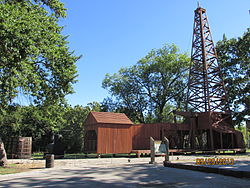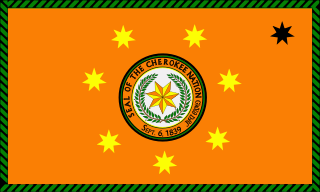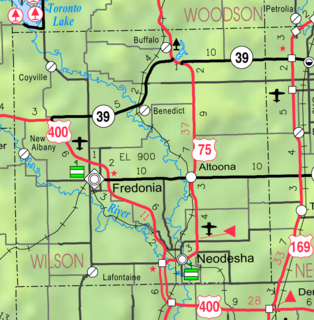
The first successful oil well in North America was established in Oil Springs, Ontario, Canada in 1858. The field is still in production although quantities are low.
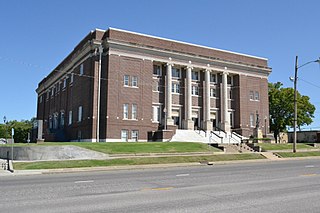
Montgomery County is a county located in the U.S. state of Kansas. As of the 2010 census, the county population was 35,471. Its county seat is Independence, and its most populous city is Coffeyville.

Washington County is a county located in the northeastern part of the U.S. state of Oklahoma. As of the 2010 census, the population was 50,976. Its county seat is Bartlesville. Named for President George Washington, it is the second smallest county in Oklahoma in total area, adjacent to the largest county in Oklahoma, Osage County.

Osage County is the largest county by area in the U.S. state of Oklahoma. Created in 1907 when Oklahoma was admitted as a state, the county is named for and is home to the federally recognized Osage Nation. The county is coextensive with the Osage Nation Reservation, established by treaty in the 19th century when the Osage relocated there from Kansas. The county seat is in Pawhuska, Oklahoma, one of the first three towns established in the county. The total population of the county is 47,987.

The Mid-continent oil field is a broad area containing hundreds of oil fields in Arkansas, Kansas, Louisiana, New Mexico, Oklahoma and Texas. The area, which consists of various geological strata and diverse trap types, was discovered and exploited during the first half of the 20th century. Most of the crude oil found in the onshore mid-continent oil field is considered to be of the mixed base or intermediate type.

The Drake Well Museum and Park is a museum that interprets the birth of the American oil industry in 1859 by "Colonel" Edwin Drake along the banks of Oil Creek in Cherrytree Township, Venango County, Pennsylvania in the United States. The museum collects and preserves related artifacts. The reconstructed Drake Well demonstrates the first practical use of salt drilling techniques for the extraction of petroleum through an oil well. A historic site, the museum is located in Cherrytree Township, 3 miles (4.8 km) south of Titusville on Drake Well Road, situated between Pennsylvania Routes 8 and 27. The museum is accredited by the American Alliance of Museums.
William Wayne "Bill" Keeler (1908–1989) is best known as the last appointed and first elected Principal Chief of the Cherokee Nation in the 20th century. Educated as a chemical engineer, he worked for Phillips Petroleum Company, where he became chief executive officer at the end of a long career with the company. He was one-sixteenth Cherokee, and throughout his life he also worked in the federal government for the advancement of Indians. President Truman appointed him as Principal Chief of the Cherokee Nation of Oklahoma in 1949. He also served as chairman for the executive committee of the Texas Cherokees and Associate Bands from 1939 until 1972. In 1971, he became the Cherokees' first elected chief since 1903.
Frank Phillips was the founder of Phillips Petroleum in Bartlesville, Oklahoma in 1917, along with his brother, Lee Eldas "L.E." Phillips Sr. In 2002, Phillips Petroleum merged with Conoco Oil Company and became ConocoPhillips.

The Osage Hills is a hilly area in Oklahoma, commonly known as The Osage. The name refers to the broad rolling hills and rolling tallgrass prairie and Cross Timbers encompassing Osage County and surrounding areas, including portions of Mayes, Tulsa, Washington and Kay Counties. The Osage is the southern extension of the Flint Hills of Kansas.

Owen Park is a residential neighborhood and historic district in Tulsa, Oklahoma. Its borders are Edison Avenue on the north, the municipal Owen Park on the east, the Keystone Expressway on the south, and Zenith Avenue on the west. Opened on June 8, 1910, it was Tulsa's first municipal park. The district covers 163.48 acres (66.16 ha), while Owen Park itself covers 24 acres (9.7 ha) on the east side of the District.

Well No. 4, Pico Canyon Oilfield, located about seven miles (11 km) west of Newhall, California, in the Santa Susana Mountains, was the first commercially successful oil well in the Western United States and is considered the birthplace of California's oil industry. Drilled in 1876, it turned nearby Newhall into a boomtown and also spawned a smaller boomtown called Mentryville adjacent to the drilling site. Well No. 4 continued in operation for 114 years until it was capped in 1990. The site was designated a National Historic Landmark in 1966, and the Mentryville ghost town is now open to the public as a historic park.
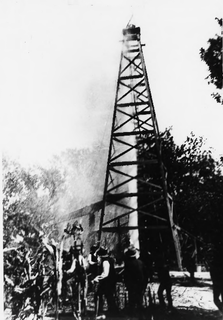
Norman No. 1 Oil Well Site is the site of an abandoned oil well, located at the northeast corner of Mill and First Streets in Neodesha, Kansas. The well, which was drilled on November 28, 1892, was the first successful well in what is now known as the Mid-Continent oil field, kicking of a major oil boom in states from Kansas to Texas and Louisiana. The well site, now a small municipal park, was designated a National Historic Landmark in 1977.
Thomas Baker Slick Sr. was born in Shippenville, Clarion County, Pennsylvania to Johnson M. and Mary A. Baker Slick. He became notable in 1912 for discovering Oklahoma's then-largest oil field, the Cushing Oil Field.

The First Oil Well in Western Canada National Historic Site of Canada commemorates the 1902 oil strike in what is now Waterton Lakes National Park, Alberta. Drilled in 1902, the well was the first productive oil well in the western Canadian provinces.
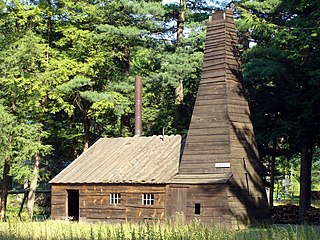
The Drake Well is a 69.5-foot-deep (21.2 m) oil well in Cherrytree Township, Venango County in the U.S. state of Pennsylvania, the success of which sparked the first oil boom in the United States. The well is the centerpiece of the Drake Well Museum located 3 miles (5 km) south of Titusville.

The First Oil Well in Oklahoma was drilled in 1885 in Atoka County, Choctaw Nation, Indian Territory, though it was not completed until 1888.

The Wheeler No. 1 Oil Well was the first well drilled in the Drumright-Cushing Oil Field of northeast Oklahoma, near Drumright. The success of the well, drilled in 1912 by Thomas Baker Slick, Sr., led to the development of the Cushing field and gave impetus to the early development of Oklahoma oilfields. The Drumright-Cushing field would go on to produce 310,000 barrels of oil a day at its peak in May 1917. The well made Slick's name as "King of the Wildcatters".

The Oklahoma City Discovery Well was the first successful oil well to be drilled in Oklahoma City, Oklahoma. The December 4, 1928 discovery opened the Oklahoma City Oil Field to extensive exploitation, creating an oil boom that sustained the area through the Great Depression. Because much of the oil was under the existing city, the Oklahoma City field pioneered the use of directional drilling to allow lateral displacement of well bores to reach deposits under developed areas.



